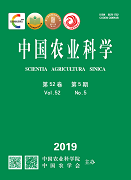【Objective】In recent years, the genetic improvement of Simmental cattle in Xinjiang has achieved certain effects, however, the genetic evaluation work has been carried out less. In order to accelerate the genetic progress of Simmental cattle, this study aims to constitute and optimize the suitable breeding program of Simmental cattle in Xinjiang by using genetic evaluation, combined with genetic trend analysis to select nucleus herd and compare the results of TPI selection and single-trait selection.【Method】The research date including the production performance records, DHI testing, mature cow weight and type classification records of 2 495 Simmental cattles, were collected from Xinjiang Hutubi Herd farm during 1974 to 2014. The DMU software was applied together with AI-REML of EM algorithm and multiple-trait animal models to estimate the variance components and breeding values of 305 MY, MFP, MPP, MLP, TS, SCS, MCW and TC. The genetic trend analysis was perfromed in 305MY, MFP, MPP, SCS and MCW. Finally, bulls and nucleus herd cows were selected by TPI.【Result】The results showed that Simmental cattle heritabilities of 305 MY, MFP, MPP, MLP, TS, SCS, MCW and TC were 0.39, 0.15, 0.12, 0.12, 0.32, 0.09, 0.60, 0.19, respectively. 305 MY, TS and MCW were high heritability (h 2>0.3) ; MFP, MPP, MLP and TC were medium heritability (0.12<0.3 ), and SCS was low heritability (h 2<0.1). Genetic trend of 305MY did not change significantly from 1974 to 2007, and appeared obviously increasing trend from 2008 to 2012. Between 1974 and 2006, genetic trends of MFP and MPP showed a slightly downward trend, and appeared obviously increasing trend from 2007 to 2013. Genetic trend of SCS appeared obviously increasing trend from 1974 to 2000, and an upward trend from 2001 to 2012 is shown. Genetic trend of MCW had a big fluctuation from 1974 to 2007, and appeared obviously increasing trend from 2008 to 2011. Breeding values for bulls and herd cows were ranked according to total performance index.The TPI value of the first bull was 552.45, and average of top 10 bulls was 383.41. Average TPI value of 100 nucleus herd cows was 214.91. Average value of 305MY, MFP, MCW and TC phenotype values of 100 Average TPI value of 100 nucleus herd cows were 7 095.10 kg, 4.13%, 696.53 kg and 76.73, respectively, which was higher than average of phenotype value in herd cows. The breeding values appeared to be different among single-trait selection and TPI . It is concluded that TPI selection was better than single-trait selection.【Conclusion】Recently, gentic trends of 305MY, MPF, MPP and MCW of Simmental cattle were appeared obviously increasing trend, and SCS was a downward trend, which further proved that breeding and genetic improvement of Simmental cattle had achieved certain results. By comparing the differences between TPI selection and single-trait selection, it is proved that selection index was more practical in production, and farm will use more bulls with high TPI values. And the population of cattle group will be expanded on the basis of 100 nucleus herd cows. By selecting excellent bulls for breeding and expanding group, the purpose was improved production of the whole group in Simmental cattle.









